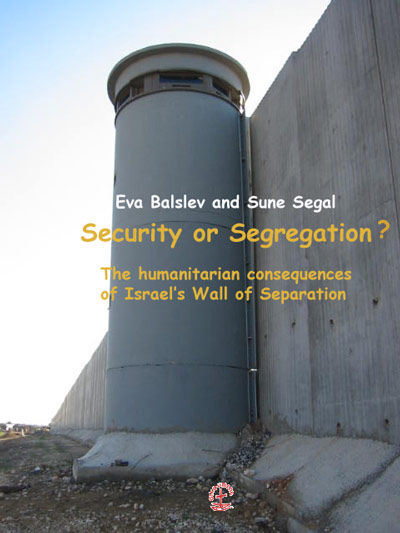| FOREWORD
In August 2002 the first group of “Ecumenical
Accompaniers” sent by the World Council of Churches (WCC) arrived
to Israel and the Occupied Palestinian Territories as part of the Ecumenical
Accompaniment Programme in Palestine and Israel (EAPPI). As a result of
the second Palestinian Intifada, WCC member churches, their specialized
ministries and related organizations from all over the world came together
under the umbrella of the World Council to create one of its boldest programmes
in direct non-violent action and resistance to the Israeli occupation
of Palestine. This was carried out in solidarity with the churches and
their communities in Jerusalem, the West Bank and Gaza Strip.
The EAPPI evolved during 2002 when the year’s focus
of the Decade to Overcome Violence: Churches Seeking Reconciliation and
Peace (2001-10) was the ecumenical campaign “End the Illegal Occupation
of Palestine – Support a Just Peace in the Middle East”, coordinated
and led by the WCC International Affairs, Peace and Human Security team.
|


Le Monde diplomatique,
Paris, July 2003, based on a map which appeared in the newspaper Yediot
Aharonot, and on field work done by Meron Rappoport
|
|
During their five-month stay, one particular issue
became ever more central in Palestinian daily life: the so-called “security
fence”, a system of fortifications Israel is currently erecting
on Palestinian lands in the West Bank in order to separate the Palestinian
population from Israel and Jewish settlements.
Months after the construction of this “wall”,
the reality and tremendous impact on the everyday life of Palestinians
was not being reflected in the reports of either international or Israeli
media. The ecumenical accompaniers gradually discovered that the official
information available was far from a comprehensive picture of the whole
project. The terminology used both by Israel and international media reports
has been misleading and insufficient to describe what is being built at
the moment: a concrete wall eight metres high, wire fences and electronic
sensors, ditches four metres deep on either side, a dirt path to reveal
footprints, a forbidden entry area, a two-lane road for army patrols,
watch-towers and firing posts.
The construction of this “wall” and confiscation
of more Palestinian land proceeds today as the Israeli authorities negotiate
land for peace with the Palestinians under the auspices of the Quartet
on the Middle East – the United Nations, the United States, the
European Union and the Russian Federation. Meanwhile, “the world
is asleep...”
The reality of how this “separation wall”
had already deprived thousands of Palestinians of a sustainable future
became a concern to two of the ecumenical accompaniers, Eva Balslev and
Sune Segal, both from Denmark. With a background in journalism, both accompaniers
felt it crucial to tell the story of how the “wall” has already
ruined the livelihoods of thousands of Palestinians and will continue
to do so as its construction progresses. Just as important was their wish
to create a basis for a sobre and factual discussion around it. In accordance
with one of the stated purposes of the EAPPI – to bear witness to
and report on human-rights violations resulting from Israel’s practices
as an occupying power – the two accompaniers devoted much of their
stay to conducting research on the subject as well as collecting testimonies
from affected villagers. This booklet provides an alternative to most
media stories, as told by two young ecumenical accompaniers to whom we
are most grateful.
Thanks are due to the former EAPPI acting coordinator
in Jerusalem, Rudolf Hinz, who was responsible for the assignment of the
first EAPPI group and supportive of both Eva and Sune. Sincere appreciation
goes to all those Palestinians and Israelis who participated in the compilation
of this report. Last but not least, I would like to extend special thanks
to another ecumenical accompanier, Sarah Gjerding, for all her work in
assisting me to ensure that this booklet sees the light of day.
6 August 2003
Salpy Eskidjian
Programme Executive
International Affairs, Peace and Human Security
Executive Coordinator of the EAPPI
World Council of Churches

Preface
While the first phase of the so-called
Road Map to a two-state solution to the Israeli-Palestinian conflict is
moving forward, albeit slowly, another less palpable process is taking
place – a process which is actively precluding a successful outcome
of the negotiations envisaged in the Road Map. Thus, at the time of writing
(August 2003) the Israeli government has completed the construction of
the first section of a physical barrier between Israel and the West Bank.
Extending approximately 145 kilometres, this section will eventually become
part of a barrier that – judging from recent Israeli confiscation
orders on Palestinian-owned land – will encircle approximately 40
percent of the West Bank, which Israel plans to allot the Palestinians
as part of a final settlement of the conflict.
Whereas it might be argued that,
historically speaking, wall-building has not proved a particularly effective
means of conflict resolution, the separation wall presents another more
immediate problem. According to Israel the wall is meant solely to prevent
suicide bombers from entering Israel from the West Bank. However, the
wall does not follow the 1949 armistice line, the so-called Green Line,
which constitutes the unofficial border between Israel and the West Bank.
Instead, in most places the wall runs or will run deep inside the West
Bank. The completed portion runs up to six kilometres east of the Green
Line, whereas the planned route includes, among other areas, the settlement
of Ariel some 20 km east of the Green Line. Finally, and even more disturbing,
judging from the confiscation orders, the wall will eventually be extended
to separate the future Palestinian enclaves from the Jordan Valley, thus
completely surrounding the territories supposed to constitute, in the
words of the Quartet Road Map, an independent, viable, sovereign Palestinian
state.
While the question of independence,
sovereignty and viability remains speculative, the siting of the completed
section has already had four immediate implications, namely:
1. Thousands of hectares of heavily
cultivated Palestinian farmland have ended or will end up on the Israeli
side of the wall.
2. Large tracts of Palestinian farmland have been or will be destroyed
as a result of the 50-100 meter security zone that will surround the wall.
3. When the wall is in place, many thousands of Palestinian workers depending
on jobs inside Israel will face severe difficulties or be altogether prevented
from reaching their work-place.
4. At least 13 Palestinian villages will end up in a no-man’s land
between the wall and the Green Line.
In other words, the wall is not only
an obstacle to the Palestinian state envisaged in the Road Map. It also
severely infringes human rights, most importantly:
the right to property
the right to work
the right to an adequate standard of living
the right to freedom of movement
The primary aim of this publication
is to convey an impression of what these infringements look like on the
ground. Therefore, the focus in the following pages is on the physical
reality engendered by the fact that the wall is being built east of the
Green Line, i.e. inside the West Bank.
However, because Israel claims that
the above-mentioned infringements are lawful, since the wall is intended
to provide security to Israel’s citizens, some of the more technical
and legal aspects of the question are briefly discussed in the chapter
“The legal issues – security vs. human rights and international
humanitarian law”.
The diary sections are based on three
field visits by the authors to Falamiya, a small village which lies in
the West Bank near the Green Line, which has been heavily affected by
the construction of the wall. During each of their visits, the authors
stayed in Falamiya for several days and had the opportunity to conduct
in-depth interviews and engage in informal discussions with a number of
Falamiya’s residents. Moreover, these field visits provided the
authors with first-hand experience of the situation on the ground, i.e.
the progress of construction work, the ensuing confiscation and destruction
of farmland and, not least, the sentiments of the residents of Falamiya.
The factual information relies on
various sources, mainly Palestinian and Israeli, all listed under "References".

FACTS
ABOUT THE WALL
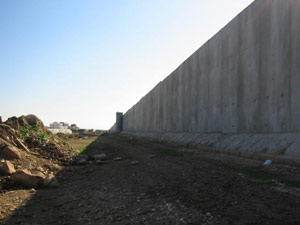
The
8-metre-tall wall in Qalqiliya that encircles the town and only leaves
the 35,000 residents with one checkpoint |
When?
- Construction began in June 2002; the first 145 kilometres were completed
in July 2003.
Where?
- The first section extends for approximately 145 kilometres, from
the Palestinian village of Salem near Jenin in the northern West
Bank to the Jewish settlement of Elqana, south of Qalqiliya.
|
|
- The wall does not follow the internationally recognized
border, the so-called Green Line, between Israel and the West Bank.
Instead, in most places it runs or will run several kilometres inside
the West Bank.
- In the future the wall will most likely be extended
to separate the Palestinian enclaves in the West Bank from the Jordan
Valley, thus completely surrounding these enclaves.
What?
- In most places the wall consists or will consist of a three metre-high
fence; however, in some places it takes or will take the form of
an eight metre-high concrete wall.
- A 50-100 metre-wide security zone will run along each side of
the fence/wall. The zone will comprise electronic movement sensors,
surveillance cameras, a four metre-deep moat, a two-lane patrol
road, stacked rolls of barbed wire and fine sand to detect footprints
of trespassers.
- The city of Qalqiliya
is already surrounded by an eight metre-high concrete wall equipped
with watchtowers every few hundred meters. Five kilometres of the
wall is already in place. The Qalqiliya wall extends for eight kilometres,
completely surrounding the city except for a narrow passage on the
city’s eastern border.
Cost
- The cost is approximately two million dollars per kilometre. |
The
wall and the security zone with patrolling roads
 |

|
| Confiscation
of land Red
plastic bands and written land confiscation orders pinned on the stems
of their olive and lemon trees were the first signs warning Palestinian
farmers living close to the Green Line that they were about to lose their
livelihood.
At first a number of farmers attempted
to object to the Israeli authorities. However, all they achieved was to
postpone the inevitable. At present none of them believes that protests
will have any effect whatsoever.
Security or land grab?
The Israeli Ministry of Defence (MoD), which is formally in charge of
the construction of the fence, has been very secretive regarding the exact
route of the wall. Although maps based on land confiscation orders have
been produced by various Israeli and Palestinian human-rights organizations,
in reality Israel seems to have decided on the actual route of the wall
as it went along. |
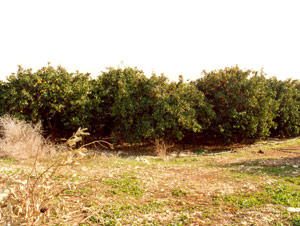
An olive grove
in Falamiya, before...
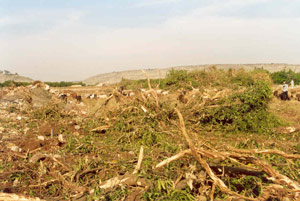
... and after
|
|
What the more or less finished route has revealed is that
the wall will be surrounded by a so-called security zone varying in width
between 50 and 100 metres. The first portion of the wall has thus resulted
in the destruction of an estimated 600-1200 hectares of Palestinian farmland.
This, however, is nothing compared to the amount of land
that has ended up on the Israeli side of the wall, namely about 100 square
kilometres out of the West Bank’s 5800 square kilometres. The bulk
of the confiscated property is agricultural land with olive trees, vines,
seasonal fruit trees and various field crops.
Furthermore, it is estimated that 36 communities east
of the wall will be cut off from their agricultural land. In most cases,
agricultural production constitutes the villages’ main or only source
of income. In these 36 communities alone some 72,000 Palestinians will
thus be partly or totally deprived of their livelihood.
In total, the livelihood of some 210,000 Palestinians
has been or will be negatively affected by the first section of the wall.
In no-man’s land
The MoD claims that the location of the wall is dictated by topography
– in other words, that the route is planned in such a way as to
provide maximum security to Israel.
However, this claim has been disputed by observers on
both sides. Most importantly, in many places the wall actually runs through
low points in the landscape – a fact in obvious conflict with the
claim that maximum security is the only concern.
One claim that has been raised by Palestinians as well
as Israeli critics is that the route is decided by the demands of Jewish
settlers living in West Bank settlements close to the Green Line. Whether
this is indeed the case remains an open question, but facts are that ten
Israeli settlements currently east of the Green Line are now situated
on the Israeli side of the wall.
A side-effect is that at least 13 villages with 11,700
residents will be trapped in a no-man’s land between the wall and
the Green Line. The future legal status of the residents of these villages
is not yet clear, but they will certainly not gain Israeli citizenship.
Whether they will be allowed to keep their West Bank ID is likewise unclear.
|
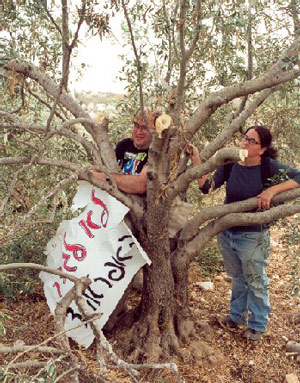
Activits Adam
and colleague clinging to a Falamiya olive tree

The Israeli worker
David with the chain-saw in the Falamiya olive grove
|
Diary
of Falamiya – A village on the road to dependency – part 1
Man with chainsaw: “If I don’t do it, someone
else will.”
Man hugging olive tree: “That’s what people
in Nazi Germany used to say.”
Man with chainsaw: “Well, at least Hitler was a
leader who knew what he wanted.”
Man hugging olive tree: “Are you saying that you
admire Hitler?”
Man with chainsaw: “God forbid, no! My grandparents
were killed at Auschwitz.”
Land grab
This peculiar exchange takes place between two Israelis
with different agendas to say the least. From his position between the
branches of a partly cut down olive tree, Adam is trying to persuade David,
the chainsaw man, to halt his work. The request does not go down well,
however. David revs up his tool and brings the snarling machine down on
a branch dangerously close to Adam who clings to the trunk. So close,
in fact, that the blade brushes Adam’s forearm, inflicting a superficial
cut.
The meeting occurs in an olive grove near Falamiya, a
small Palestinian village of approximately 700 inhabitants, situated in
the West Bank between the cities of Qalqiliya and Tulkarem, some three
kilometres from the border with Israel.
|
|
Falamiya is a farming community which makes its living
from the fertile, well-irrigated lands along the northern part of this
border – a livelihood now threatened by the fact that 28 square
kilometres of terrain constituting three-quarters of the village’s
land with its tens of thousands of olive and citrus trees will eventually
end up on the Israeli side of the so-called security fence.
As the over-riding majority of Falamiya’s income
stems from olive and fruit production, and as the residents were totally
unprepared for this situation, they have no alternative sources of income.
The consequences will therefore quite simply be catastrophic should the
project be carried through as planned.
Adding to the seriousness of the situation is the fact
that access to the area’s vast reserves of high-quality groundwater,
currently distributed through an extensive, French-sponsored irrigation
system, would be lost, as the majority of the area’s wells would
also end up on the wrong side of the fence. In short, the worst-case scenario
is that Falamiya would not only lose most of its land, but also its access
to those water resources that are essential for irrigating the remaining
groves.
Finally, the 50-100 metre
wide security zone that will surround the fence would eventually lead
to the cutting down of many thousands of olive and citrus trees.
Unlikely adversaries
It is precisely this last task on which David has embarked: his job is
to clear the way for the bulldozers that will follow to straighten out
the jagged terrain. However, David is facing obstacles, as Adam is not
alone in his effort to protect the trees.
Far from it. For the past couple
of days, Falamiya has been the centre of attention in a campaign by international
activists to protest the destruction of Palestinian land in connection
with the construction of the fence. Some seventy foreign nationals of
all ages have invaded Falamiya within the past two days, increasing the
town’s population by more than a tenth.
Their presence brings some hope to
the people of Falamiya, among them Rasheed Abu Mohammed, 65, who owns
11 hectares of citrus groves and greenhouses in Falamiya, and his son
in law, Sami, a very energetic, red-faced and persistently smiling man
in his mid-thirties. Sami is all over the place, talking to people, outlining
the situation, getting excited about the rumours flitting back and forth:
“The BBC is going to come here tomorrow”, “Sky News
is going to do a story”, “Both The Guardian and The Independent
will be here”.
But what encourages Rasheed and Sami
more than anything else is that the French consul in Ramallah has responded
positively to their appeal that he visit Falamiya. The consul, whose government
has, as mentioned, sponsored the area’s irrigation facilities, has
agreed to come to the village in order to negotiate with the Israeli contractor
in charge of the actual construction of the wall. So basically the challenge
is to delay the work until the consul arrives.
However, delays are something with
which the contractor is not happy at all. In fact, he has been far-sighted
enough to hire guards from a private Israeli security company –
four of a kind, each equipped with two handguns and a sub-machinegun,
all of them seemingly cut from the same template – gangly and very
aggressive 20-year-olds.
Their task consists in escorting
David on his rampage through the groves. Not that David really seems to
need their protection. With his shaven head, muscular body, tattoos and
a bright blue and hugely challenging gaze, he radiates a clear message.
A message that becomes manifest on
more than one occasion when he explodes in fits of uncontrolled rage:
for instance when he runs up to a bespectacled German woman in her late
twenties and punches her in the stomach, or when he waves his saw in front
of another activist’s face screaming “I’m gonna kill
you, I’m gonna kill you.” |
Success
To add to the general confusion, the scene is watched by a group of Israeli
soldiers deployed to police the situation – a job they carry out in
a somewhat random fashion. Thus the soldiers’ attention is suddenly
drawn to something else far away just as one of the armed guards grabs a
tiny and utterly unthreatening American girl and shoves her with all his
might, sending her tumbling several metres across the rugged soil. |

Rasheed Abu Mohammed
discussing with IDF soldiers |
Some way
off, Rasheed Abu Mohammed is in discussion with an IDF (Israeli Defence
Force) officer, trying to persuade him to make the contractor halt his
work, at least until the next morning when the French consul is due to
arrive.
Eventually, in spite of the hostilities,
the activists’ efforts seem to pay off. In any event, whether it’s
because it’s getting late anyway or because the contractor does
in fact decide to yield to the protests, he decides to call it a day.
The coming of the consul
The big morning arrives. Dozens of activists and what seems to be half
of Falamiya’s population are gathered in Rasheed’s home.
At 10 a.m., just half an hour late, the consul arrives.
He is seated in the spacious reception hall of Rasheed’s house.
Various factions put the problem to the consul. Falamiya’s farmers,
Palestinian officials – among them representatives of the Palestinian
Hydrology Group – and activists from various international movements
put forward requests to the French government to exert pressure on Israel
to build the fence on the Green Line. The consul in turn addresses the
gathering, stating that he’ll do what he can.
The motley group takes off: the consul and his aides,
Palestinian doctors and farmers, engineers and lawyers, local teenagers
waving the ‘Tricolor’ that moments ago adorned the facade
of Rasheed’s house, a few journalists from smaller media, graphic
designers from Spain, German students, Dutch clerks and an Israeli punk.
As the delegation makes its way through the groves, the
hydrologists outline the facts on the ground for the consul, showing him
various maps and pointing out the land to be confiscated by Israel. They
inform him that even though the Israelis say they’ll allow the owners
access to their land, from previous experience they’re more than
sceptical that this promise will be honoured – a concern arising
from the fact that there has yet to be an actual case of Israeli-confiscated
Palestinian land being returned to its original owners.
Defeat
Having been extensively briefed on the situation, the consul takes off
to meet the contractor and an Israeli representative by the area’s
main well. As his car disappears down the track between dark-leafed lemon
trees, the delegation follows on foot.
At the same moment a crack of thunder rumbles in the distance.
Within minutes, the rain is coming down in sheets. No shelter around,
only trees and muddy soil. The delegation, all of its members now totally
drenched, makes its way towards the point where the fateful meeting is
taking place.
However, it turns out that two IDF jeeps and four soldiers
have blocked the track. No one is allowed to go near the well, a voluminous
concrete construction, in the shelter of which the consul, the contractor
and the Israeli government representative are discussing the fate of Rasheed,
Sami and the rest of Falamiya’s residents.
The delegation decides that it might as well begin to
head back to Falamiya. Spirits are high, something is being done about
the problem, at consular level at that. Back in Falamiya half an hour
later, it turns out the result has already been announced. The contractor
has given the consul a guarantee that no harm will be done to any of the
installations donated by France. As for the route of the fence, it will
remain unchanged.

Confiscation of water - Dry future
prospects
Israel’s separation wall will not only engulf vast
tracts of Palestinian farmland. It will also put Israel in control of
a significant portion of the West Bank’s water resources.
Water is a central issue in the Palestinian-Israeli conflict.
The permanent water shortage in the region means that vast expanses of
Palestinian West Bank farmland are currently drying out. Already, thousands
of families do not have running water in their homes. Once the fence is
up, the situation will deteriorate even further as the wall will engulf
scores of Palestinian wells.
Allocation of water
The Palestinians are in control of 17 percent of the West Bank’s
total water resources. The remaining 83 percent are used by Jewish settlers
or diverted into Israel. The average West Bank Palestinian is allowed
to consume approximately 70 litres of water per day for domestic use.
WHO’s recognized minimum allocation is 100 litres per capita per
day.
The total amount of water, including water for agricultural
and industrial use, allocated to the Palestinian population in the OPT
(Occupied Palestinian Territories) amounts to some 227 liters per capita
per day. The corresponding amount for Jewish settlers in the OPT is 4000.
Israel in control
Mainly because of its rich water resources, the area around Falamiya and
Qalqiliya is among the most fertile in the West Bank. Qalqiliya is situated
on top of the so-called Western Aquifer System (WAS) – the richest
of the three groundwater basins in the West Bank.
Thirty-two wells have already been annexed by Israel,
depriving the Palestinians population in the West Bank of some 18 percent
of their share of the WAS. However, Israel will not only confiscate wells.
Eventually, it will also be in near-total control of the entire WAS, which
produces approximately 50 percent of the West Bank’s fresh-water
resources. Israel ensures this control by building the wall in such a
way that it leaves the most productive zones of the system on the Israeli
side of the fence.
Palestinians fear that Israel will not only control the
water resources, but also use them. This would leave the Palestinians
with only the Eastern Aquifer System, which is already exhausted. In any
case, Israel has not allowed the Palestinians to drill new wells there
since 1967.
A joker for future negotiations
It is expected that the extensive loss of water resources will affect
the lives of tens of thousands of Palestinian families. Currently, some
200,000 Palestinians living in the West Bank are not connected to a water
network. Instead, they depend on cisterns. This number will very likely
grow.
Needless to say, the impact on the Palestinian agricultural
sector of the partly man-made water shortage is devastating. Traditionally,
olives, lemons, oranges and vegetables are the principal West Bank exports.
Losing these means losing the major source of income in a situation where
there are few or no alternatives, since most Palestinians who used to
work in Israel have lost their jobs while local businesses are closing
down as the economy collapses.
Finally, Palestinians fear that in future negotiations
Israel will argue that there is no urgent need for water in the West Bank,
since large tracts of irrigated Palestinian farmland will have been confiscated.

|
| 27 November
2002
Diary of Falamiya – A village
on the road to dependency - part II
|
| The hope of Falamiya’s
inhabitants is evaporating at the same speed at which the bulldozers gobble
away at their livelihood. Not a single international activist is left. During
the past ten days, thousands of olive and citrus trees have been lost.
In a fog of cigarette smoke, a few men from the village
sit around lamenting their loss. It is Ramadan, but the holy month’s
ban on consuming food, water and cigarettes during daylight is largely
ignored. A combination of cheap, home-made cigarettes and sardonic humour
seems to be the immediate way of coping with the inescapable reality.
“If we can’t demonstrate against the Israelis, we can demonstrate
against God,” Ahmed Said, a young farmer, says with a laugh.
Daily losses
Facts are that so far, Israeli bulldozers and excavators guarded by IDF
soldiers have dug out some 100 metres of ditch in preparation for the
foundation of the fence. Seven thousand trees lie in big piles on the
ground, their branches still heavy with almost ripe oranges.
|
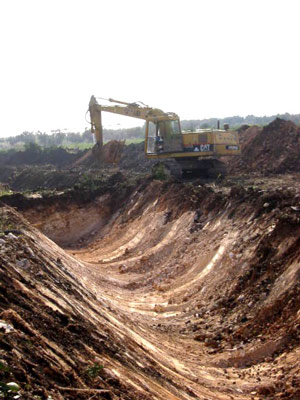
The ditch for the
wall in the midst of the citrus grove in Falamiya |
Rasheed Abu Mohammed
walks aimlessly around his groves. He knows that in the near future, he’ll
lose all of the eleven hectares that feed him and his ten children. Only
this morning, Israeli soldiers prevented his son Mohammed from going to
the groves, stating that the area is a now a closed military zone.
Abu Mohammed’s sun-baked wrinkles
express resignation as he stands between his trees. “I love my land
like I love my children. I have worked here all my life - I have spent
time on every single tree,” he says. |
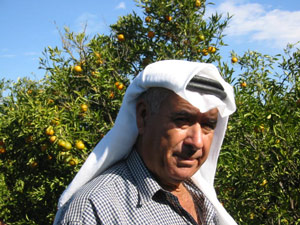
Rasheed Abu Mohammed
in his citrus grove: "I love my land like I love my children. I have
worked here all my life - I have spent time on every single tree,"
he says |
| Abu
Mohammed forces himself to go to his land every day although he feels that
it is an altogether futile exercise. The oranges are not ripe, but he has
started harvesting them anyway to make the most of what seems to be his
last harvest. Usually he would make 20 shekels (4,5 USD) for each box of
oranges. He now sells them at four shekels, losing 4-5,000 shekels every
week.
Broken promises
In 1958 Abu Mohammed’s father found groundwater on his land and
drilled the well that has made the family’s land flourish. Walking
slowly back to the village, Abu Mohammed points to a water pipe running
through the fields. It is connected to the well and provides water for
150 hectares of the village’s land.
“The Israelis promise us that we
will get access to the water even when the wall is up. But they are lying
– they never keep such promises. Why would they build the wall here
if it weren’t precisely in order to steal our wells? What they want
is land and water for new settlements,” he says, while resting for
a few minutes by the side of the road. “Some of the fields will
not be confiscated, but what good is that when we cannot irrigate them?”
he asks with a sarcastic grin. “In the future, all I will be able
to do to is sit in my house and grieve. This is like building a house,
creating a home, and then having uninvited strangers move in and take
it over.”
|
Disappointment
Ibrahim Abu Khaled, Abu Mohammed’s cousin, is accompanying his relative
on his walk through the groves and fields. Abu Khaled, who is 64, has had
no income since the outbreak of the second Palestinian uprising some two
years ago.
Up to that time, the future looked reasonably bright.
Abu Khaled had returned to his native village of Falamiya in 1994 after
spending thirty years abroad, most of them in Germany. Upon his return,
he opened a dry cleaners in the nearby city of Qalqiliya, right on the
Green Line. The business provided for him and his family, as well as for
six young men from the village who worked for him.
|
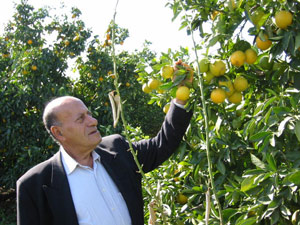
Abu Mohammed's cousin
Ibrahim Abu Khaled |
| With its
well-stocked market and low prices, Qalqiliya drew many Israeli customers.
In fact, Israelis made up a significant part of Abu Khaled’s clientele
since his prices easily beat those found in Israel. However, over the past
two years Israel’s military invasions and curfews have slowly but
steadily killed Qalqiliya’s business-life. On top of that, the city
is now surrounded by an eight-metre high concrete wall - yet another piece
of the separation wall. The wall has dashed any hope that the Israeli customers
will return.
“All I wanted when I returned after all those years
abroad was to establish my own business, build a nice house for my family
and then in due course retire with the savings from the store,”
he says. He did indeed build the house he had dreamed of. However, he
did not manage to save money for his retirement.
Later when dinner is being digested and clouds of cigarette
smoke once again gather over the men, Abu Khaled expresses relief that
at least he has only got two children. Pointing to his companions, he
says: “They have made a big mistake having so many children. Most
of them have six, seven, eight children. How are they going to create
a future for them?”
Israeli help
He then moves on to explain that the inhabitants of the neighbouring Israeli
town of Kokhav Yair, which is situated just across the Green Line, attempted
to help the people of Falamiya.
“The mayor of Kokhav Yair actually sent a fax to
Sharon, asking him not to take our land – he explained that there
have never been any problems whatsoever between Falamiya and Kokhav Yair.”
“Of course it will not make any difference, they’re going
to build the fence no matter what. But the point is that there has never
been a suicide bomber from Falamiya. What I don’t understand is
why we have to be punished for what someone else did.”

THE LEGAL
ISSUES - SECURITY vs. HUMAN RIGHTS AND INTERNATIONAL HUMANITARIAN LAW
The need for security occupies every Israeli mind; it
has resulted in a majority of the Israelis supporting a unilateral separation
from the Palestinians in the West Bank. But can Israel’s military
needs justify the infringements of human rights resulting from the construction
of the wall? And what are the implications of the wall in relation to
international humanitarian law, e.g. the Fourth Geneva Convention?
1. Infringement of human rights
As should be clear from the preceding pages, the wall infringes human
rights, among them:
The right to property
The right to work
The right to an adequate standard of living
The right to freedom of movement
Israel claims that these infringements are lawful since
the wall is intended to meet what is coined as “imperative military
needs”, i.e. to reduce the number of Palestinian attacks inside
Israel.
To be sure, certain infringements of human rights are
allowed where a legitimate military objective exists. Moreover, Israel’s
stated rationale for building the wall is indeed a legitimate military
objective. In other words, erecting a wall such as the one that is currently
under construction is not necessarily in conflict with human
rights.
However, for military needs to legally infringe human
rights, there must be an absence of alternative means that cause lesser
infringements. Concerning the case in point, Israel is therefore obliged
to place the wall in a manner that causes the least possible infringement
of the human rights of the affected population.
The actual siting of the wall does not live up to this
obligation. Furthermore, the siting strongly indicates ambitions other
than those of merely improving security in Israel. Finally, Israel has
at no point put forward any legal claim justifying the siting.
2. International humanitarian law
Confiscation of private property is illegal
International humanitarian law (IHL) prohibits the confiscation of private
property. Article 53 of the Hague Regulations states that “An army
of occupation can only take possession of cash, funds, and realizable
securities, which are strictly the property of the state [...].”
Article 46 states that “private property cannot be confiscated”.
Already having led to extensive expropriation of privately
owned land, the wall constitutes a clear breach of these articles.
Land grab – temporary or permanent?
IHL also prohibits permanent changes of the status of occupied territories.
Where the Hague Regulations (part of IHL) do allow occupying powers to
assume temporary administrative control of publicly owned land,
such control does not amount to property rights. Any attempt by an occupying
power to permanently confiscate land (annexation), public or private,
is thus illegal.
Concerning the wall, the question is therefore whether
it is in essence a temporary or a permanent venture.
Israel claims that in building the wall it is merely exercising
the right provided by the Hague Regulations to assume temporary administrative
control – and the military orders used to seize land in connection
with the construction of the wall are indeed provisional (valid until
31 December 2005). Moreover, Israel claims that even though the land of
a number of Palestinian farmers will end up on the Israeli side of the
wall, those farmers will be allowed to access their land through gates
in the wall.
However, precedent as well as the current situation on
the ground point in a different direction. Firstly, the orders in question
can be indefinitely renewed. Secondly, precedent indicates that in reality,
IDF land confiscation orders are in effect permanent.
The precedent in question is the IDF military confiscation
orders used in the 1960s and 1970s to seize lands to build Jewish settlements
in the OPT. At that time the pretext was security needs. This changed
in 1979 when the Israeli high court approved the establishment of the
settlement of Elon Moreh near Nablus. This case represented the first
instance where expropriation of private land for reasons other than military
necessity was approved in an Israeli court. Since then, the Jewish settlements
in the Occupied Palestinian Territories have acquired a status of ever-growing
permanency with an extensive and well-maintained infrastructure, industrial
zones, intensive agricultural production and housing facilities, indicating
anything but an interim situation. In short, the territories confiscated
for the building of these settlements have in effect been annexed to Israel.
Annexation is illegal
The fact that the areas confiscated are among the most fertile and well-irrigated
in the region seems to support the allegation that the confiscations will
indeed be permanent and that they therefore amount to annexation, i.e.
the permanent incorporation of seized territories into the territory of
the occupying power. Annexation is a violation of the general principle
under customary international law and the UN charter of the inadmissibility
of acquisition of territory by force.

|
| Diary
of Falamiya – A village on the road to dependency – part III
It’s almost as if he wants to punish himself. As
the sun slowly rises to shine down on the hilly groves, Rasheed Abu Mohammed
sits quietly on a plastic chair contemplating the view, letting his gaze
wander across the landscape. In the distance dusts clouds rise and dance
to the rhythm of the pneumatic drill which continues to beat away on the
barren rocks.
The cutting-down of trees seems to have ceased for the
time being. On the other hand, the bulldozers and excavators have claimed
a new victim. Several water pipes, all part of an irrigation system that
usually waters some 150 hectares, have been destroyed.
“The French consul
was here again not long ago to check on the pipes,” relates Abu
Mohammed. “He asked the soldiers what happened to the pipes. They
claimed that we had destroyed them ourselves,” he says with a contemptuous
laugh. “Since it’s winter right now, water is not a problem.
But in a couple of months there will be no rain.” He sits quietly
for a while, then breaks the silence, saying out loud the name of his
cousin, Ibrahim Abu Khaled, while pointing to the sky, indicating the
new home of his cousin. |
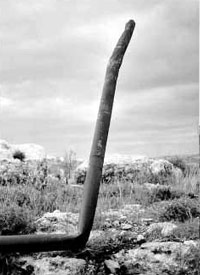 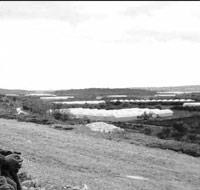
A destroyed water
pipe in the Falamiya fields near the wall construction site

Rasheed Abu Mohammed
looking at the Falamiya landscape and claiming the world is asleep
|
| Lethal
anger
On the last day of Ramadan, one of the most important days of celebration
in the Islamic calendar, a heart attack ended Ibrahim Abu Khaled’s
life.
His widow Shitam is sitting in her
living room, surrounded by her sisters and friends. The crowded room doesn’t
change her feeling of being left behind. She partly blames Ibrahim’s
large intake of cigarettes for his death, but according to her at least
one other major player was present when his heart let him down at the
age of 64.
“He was so angry about the
situation. The anger was bottled up inside him - the anger helped death
on its way,” says Shitam as she explains how a severe chest pain
woke Ibrahim in the middle of that fatal night. “He told me to get
a doctor,” she says and explains that friends took him to a doctor
in the nearby village of Kafar Jammal. The doctor immediately gave him
a heavy dose of medicine, supposed to keep him alive long enough for an
ambulance to arrive from the town of Tulkarem, some 15 kilometres from
Falamiya.
But the ambulance didn’t take
the usual ten minutes to reach Kafar Jammal from Tulkarem. Military checkpoints
and roadblocks prolonged the trip by half an hour. The ambulance was still
on its way when Ibrahim’s heart stopped as he was attempting to
climb a roadblock outside of Falamiya.
As Shitam relates her story, Zuheir
Abdel-Hadi, a friend of the family, enters. He shakes his head as he lets
himself fall on the soft couch. Moments ago, his 13-year old son was playing
in the fields with a couple of friends when suddenly the Israeli constructor’s
security guards opened fire in their direction.
“They were shooting at my child!
All my son did was to play in the fields with his friends. Our fields!
My son, the children here, they have never been confronted with these
things before. He was so scared,” he says, shaking with frustration.
While the world sleeps
Shifting slightly in his plastic chair, Abu Mohammed continues
to stare across the fields as he slurps on the morning’s fifth cup
of sweet tea. To the unsuspecting eye this is a pleasant place, even idyllic.
The sun is up now, its pale wintry rays caressing the dust-green hills,
the silence is almost perfectly serene, apart from the chirping birds
mingling with the slow beat of the drill.
“It is a crime,” he says.
“They are taking away our land, our water, our subsistence. And
the world is asleep.”

Epilogue
It should be stressed that the destruction of their livelihood
resulting from the erection of the wall affects not only Falamiya’s
residents, but also the livelihood of several thousand Palestinian farmers
in some thirty other villages near the Green Line.
Palestinian organizations have compared the future status
of these villages with that of the 59 Palestinian refugee camps in the
OPT and the neighbouring countries. The comparison is precise: each of
these villages - a “village” meaning a cluster of houses as
well as the surrounding farmland on which the residents of those houses
depend for their subsistence – is being transformed into clusters
of houses with no land and hence with no sustainable means of subsistence;
that is, a situation identical to that of a refugee camp. The term “village”,
and all of its connotations of “home”, “family”,
“safety”, “stability”, and so forth, is quite
simply rendered meaningless as the entity it normally describes is deprived
of one of its essential components. In short, a cluster of houses without
land is as little a village as some farmland without houses.
The Israeli authorities have promised that crossing points
will be set up in order to enable farmers, whose land has ended up on
the Israeli side of the wall, to tend their fields and groves. However,
crossing these points will require a “special permit” and
will leave the farmers completely dependent on Israel’s security
assessments and the whim of the soldiers manning the crossing points.
Moreover, past experience at the well over 100 Israeli military check-points
in the West Bank clearly shows that the connection between alleged security
concerns and the relative difficulty of crossing check-points is often
negligible. For example, soldiers frequently close up checkpoints if they’re
unsatisfied with the behaviour of those waiting to pass. Crossing such
points is thus at best a time-consuming, humiliating and dangerous experience.
At worst, check-points are closed for days on end. Needless to say, such
a situation is unsustainable for any farmer anywhere in the world.
Finally, it should be noted that not only farmland, trees
and greenhouses have been destroyed and/or confiscated. In the town of
Nazlat Issa on the northern sector of the Green Line, the Israeli army
demolished 62 out of 170 shops in the town market in January 2003, thereby
depriving the shop-owners of their only income. Israel alleged the shops
were built illegally. However, whether this is actually the case or not
seems immaterial in view of the fact that the Israeli authorities had
ignored this for more than ten years. The Israeli Ministry of Defence
is currently planning to build a wall in the very same area where the
now-demolished shops once were in order to separate Nazlat Issa from the
Arab Israeli village Baka Al-Gharbiyeh, to which it is physically connected.
Also, in the time that has elapsed since the authors made
their last visit to Falamiya at the beginning of January 2003, the village
of Al-Daba in the Qalqiliya area has received confiscation orders on all
of the villages’ 42 houses, 60-70 hectares of land, a mosque and
an elementary school for 132 children.
In conclusion, Israel’s continued de facto annexation
of Palestinian land creates a fundamental and ever-growing obstacle to
the establishment of an independent, viable, sovereign Palestinian state
at the very moment when a road map towards a viable Palestinian state
is being negotiated. As explained in the introduction, the Israeli government’s
plan for the completion of the wall does not indicate that the practice
of de facto annexation will be halted.
References
B’Tselem, “Separation
Barrier, Position Paper”, Sept. 2002.
B’Tselem, ““Behind the Barrier, Position Paper”,
April 2003.
Palestinian Environmental NGOs Network, PENGON, Report no. 1, Nov. 2002.
The Israeli Ministry of Defence, information provided by spokesperson
Rachel Naidek Aschkenazi, Oct.-Nov. 2002.
Interview with Mr Damimi, director of the Palestinian Hydrology Group,
Nov. 2002.
Palestinian Academic Society for the Study of International Affairs, Passia
diary 2002, water chapter.
Links to websites relating
to the issue:
http://www.lawsociety.org/wall/wall.html
http://www.btselem.org/Download/Separation_Barrier_Eng.doc
www.pengon.org
Back
to EAAPI homepage |
